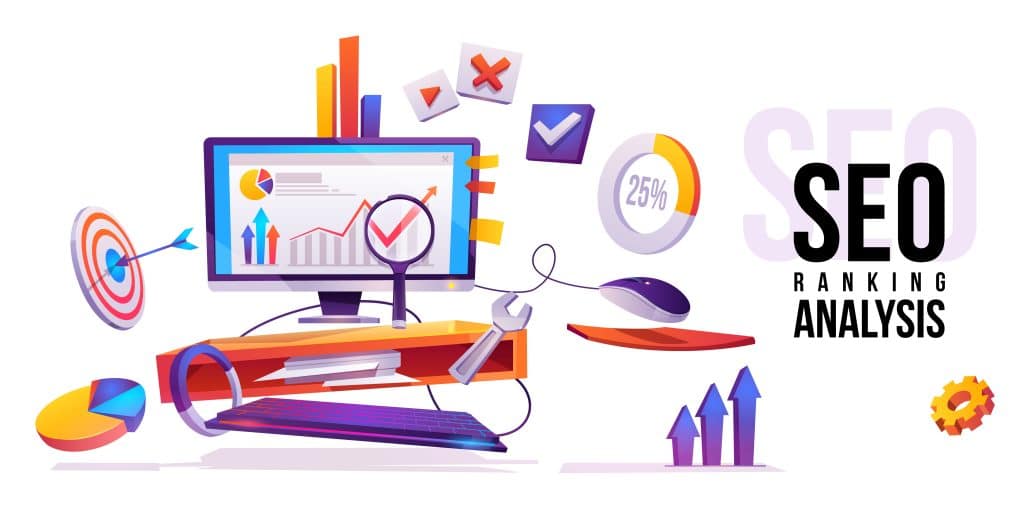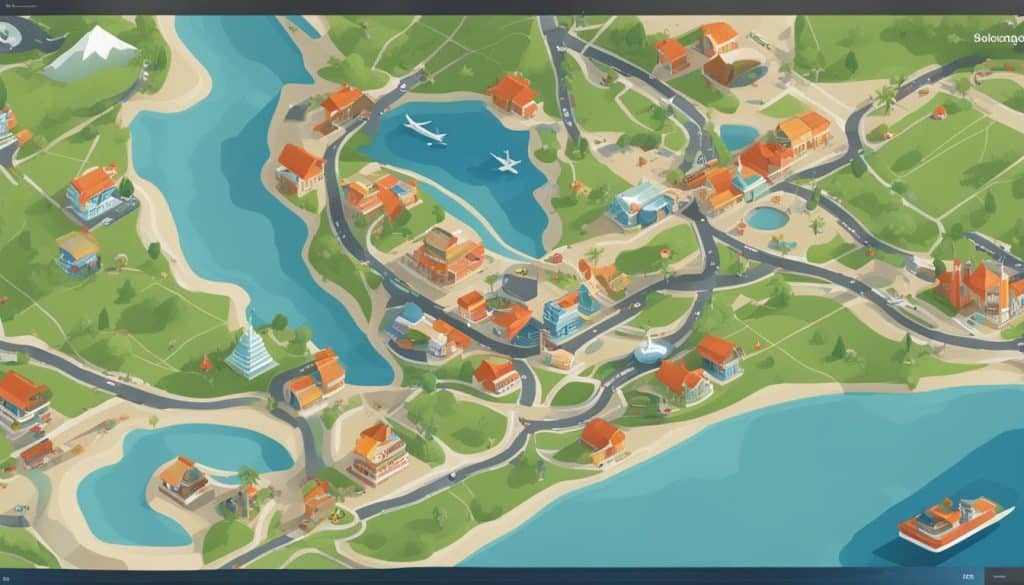Blog optimization is crucial for improving the visibility of your website and driving more traffic to your content. According to a survey, 56% of consumers have made a purchase after reading a company’s blog, and 10% of marketers believe that blogging generates the highest return on investment. Whether you are blogging for business or pleasure, implementing SEO strategies can help you connect with a larger audience and boost your message. In this article, we will explore what blog SEO is, how it can benefit your website, and techniques to optimize your blog content for search engines.
Key Takeaways:
- Blog optimization is essential for improving website visibility and increasing traffic.
- Blogging can drive consumer purchases and provide a high return on investment.
- Implementing SEO strategies can help connect with a larger audience and boost your blog’s message.
- In this article, we will explore SEO for blogs, its benefits, and techniques to optimize blog content.
- Stay tuned to learn how to maximize your blog’s visibility and improve its search engine rankings.
What is Blog SEO?
Blog SEO, or blog search engine optimization, is the practice of improving your blog’s search engine rankings. This includes keyword research, on-page optimization for blogs, link building, and content writing. Blog SEO helps make your blog more visible to people using search engines to find relevant information. It involves strategies to enhance your blog’s visibility on search engine results pages (SERPs) and attract more organic traffic.
Implementing a blog SEO strategy is crucial for improving your website’s performance and maximizing its outreach. By utilizing on-page optimization techniques, you can optimize your blog content to rank higher on search engines and attract a larger audience.
Key components of blog SEO strategy include:
- Performing thorough keyword research to identify relevant keywords and phrases to target in your blog posts.
- Optimizing your blog posts with target keywords in title tags, headings, meta descriptions, and throughout the content.
- Creating high-quality and engaging content that provides value to your audience.
- Building authoritative backlinks from reputable websites to increase your blog’s credibility and visibility.
- Optimizing your blog’s internal link structure to improve navigation and user experience.
By implementing these strategies, you can improve your blog’s visibility, increase organic traffic, and boost your website’s overall performance.
How Does Blogging Help with SEO?
Blogging plays a significant role in boosting the quality of your website’s SEO. By regularly creating informative and valuable blog posts, you can position your website as a trusted source of information and answers to your customers’ questions. But how exactly does blogging help with SEO? Let’s delve into the details:
Key Blog Ranking Factors
When it comes to search engine rankings, several factors come into play. Here are some key blog ranking factors that you should be aware of:
- Organic click-through rate: The number of users who click on your blog post when it appears in search results. The higher the click-through rate, the more authoritative and relevant search engines perceive your content to be.
- Index coverage: Ensuring that your blog posts are indexed by search engines is crucial. If search engines can’t find your content, it won’t appear in search results.
- Backlinks: High-quality backlinks from authoritative websites signal to search engines that your blog content is valuable and trustworthy.
- Internal links: Linking to other relevant blog posts within your website helps search engines understand the structure of your content and improves the user experience for readers.

Optimizing Blog Images
Images in blog posts are not only visually appealing but also contribute to SEO. Here’s how you can optimize blog images:
- Use relevant alt tags: Incorporate descriptive alt tags that include relevant keywords related to the image.
- Compress image files: Large image files can slow down the loading speed of your blog. Use image compression tools to reduce file sizes without compromising quality.
- Provide captions and titles: Adding captions and titles to your images can provide additional context and improve accessibility for users.
Improving Blog Loading Speed
Website loading speed is a crucial factor for both user experience and SEO. Slow-loading blogs can lead to higher bounce rates and lower search engine rankings. Here are a few tips to improve blog loading speed:
- Optimize image sizes: Compress and resize images to reduce their file size without sacrificing quality.
- Minify CSS and JavaScript files: Remove unnecessary characters and spaces from your code to reduce file size and improve loading times.
- Enable browser caching: Set expiration dates for static resources to allow browsers to cache them, reducing the need for re-download.
- Choose a reliable web hosting provider: Select a hosting provider that offers fast servers and reliable uptime.
By optimizing your blog images and improving the loading speed of your website, you can enhance the overall user experience and positively impact your SEO efforts.
The Importance of Blog SEO Strategy
Having a well-defined blog SEO strategy is essential for maximizing your organic search results.
In today’s digital landscape, where competition for online visibility is fierce, it’s crucial to develop a comprehensive blog SEO strategy to ensure that your content stands out and attracts the right audience. A well-crafted strategy incorporates competitive research, keyword analysis, and optimization proposals that align with your digital marketing objectives.
Search engine algorithms are constantly evolving, and staying on top of these changes is paramount to maintaining a competitive edge. With a robust SEO strategy, you can adapt to these updates, measure the effectiveness of your efforts, and allocate your resources effectively.
By implementing a well-defined blog SEO strategy, you can:
- Improve your website’s visibility on search engine results pages (SERPs)
- Increase organic traffic to your blog
- Enhance the user experience on your site
This section will guide you in developing a robust SEO strategy for your blog.
Let’s dive deeper into the key elements of an effective blog SEO strategy:
Competitive Research
Understanding your competitors is crucial in devising a winning SEO strategy. Analyze their content, keywords, and backlink profiles to identify opportunities and gaps in the market. This research will help you refine your unique value proposition and differentiate your blog from the competition.
Keyword Analysis
Keywords are the foundation of successful blog SEO. Conduct thorough keyword research to identify relevant and high-performing keywords that align with your blog’s content and target audience. Incorporate these keywords strategically in your blog posts, titles, headings, and meta descriptions to improve your blog’s visibility in search engine results.
Optimization Proposals
Optimization proposals involve implementing on-page SEO techniques such as optimizing your blog’s URL structure, improving internal linking, and optimizing meta tags. Additionally, optimizing your blog’s loading speed, ensuring mobile-friendliness, and using schema markup can significantly improve your blog’s search engine rankings.
Remember, a well-defined blog SEO strategy is an ongoing process.
Regularly monitor your blog’s performance, analyze key metrics such as organic traffic, bounce rate, and keyword rankings, and make data-driven adjustments to your strategy. By continually refining and optimizing your SEO efforts, you can maximize your blog’s visibility, attract a larger audience, and achieve your digital marketing objectives.

| Strategy | Benefits | Challenges |
|---|---|---|
| Targeted keyword optimization | Improved search engine rankings Increased organic traffic |
Keyword research can be time-consuming Competition for high-value keywords |
| Quality content creation | Engage and retain readers Build authority in your niche |
Consistent content creation Content optimization requires ongoing effort |
| Link building | Improved domain authority Increased referral traffic |
Securing high-quality backlinks Building relationships with influencers |
| Social media promotion | Expanded reach and visibility Increase in social signals |
Maintaining active social media presence Engaging with your audience |
Blog SEO Best Practices
To optimize your blog for SEO, it is important to follow blog SEO best practices. By implementing these strategies, you can improve your blog’s visibility, increase organic traffic, and ultimately enhance your search engine rankings. Let’s explore the key best practices for optimizing your blog:
1. Identify Your Target Audience
Understanding your target audience is essential for creating relevant and engaging content. Identify their needs, interests, and pain points to tailor your blog posts accordingly. Research their demographic profile, preferences, and search behavior to optimize your content effectively.
2. Conduct Keyword Research
Keyword research helps you identify the terms and phrases your target audience is searching for. Use tools like Google Keyword Planner and SEMrush to find relevant keywords with high search volumes and low competition. Incorporate these keywords naturally into your blog posts to improve your chances of ranking higher in search engine results.
3. Add Visuals
Adding visuals such as images, infographics, and videos can make your blog posts more visually appealing and engaging. Visuals help break up the text, attract readers’ attention, and enhance the overall user experience. Make sure to optimize your visuals by adding descriptive alt tags and compressing the file sizes to improve blog loading speed.
4. Write Catchy Titles
Compelling titles can significantly impact your blog’s click-through rate. Craft catchy titles that spark curiosity, convey value, and align with your target audience’s interests. Include relevant keywords in your titles to optimize them for search engines.
A catchy title can captivate readers and encourage them to click through to read your blog post.
5. Include Enticing CTAs
Call-to-action (CTA) buttons or links prompt your readers to take desired actions. Use persuasive and action-oriented language to encourage readers to subscribe to your newsletter, download an ebook, or engage with your content in other ways. CTAs help drive conversions and engagement on your blog.
6. Focus on Reader’s Experience
Your blog should provide a great user experience to keep readers engaged and coming back for more. Optimize your blog’s navigation, ensure fast page loading speed, and make your content easy to read and consume. Use headings, subheadings, and bullet points to break up the text and improve readability.
7. Implement Technical SEO Aspects
Optimizing technical aspects of your blog is crucial for better search engine rankings. Focus on website navigation and internal linking to improve crawlability and accessibility. Pay attention to meta tags, including meta titles and descriptions, to optimize your blog posts for search engines. Additionally, prioritize optimizing your blog’s page speed to provide a better user experience.
8. Consider Link Building Services
Building high-quality backlinks from reputable websites is essential for boosting your blog’s authority and improving its visibility in search engine results. Consider link building services to help you identify and secure relevant and authoritative backlinks. Building a strong backlink profile can significantly impact your blog’s search engine rankings.
9. Incorporate White Label SEO Services
White label SEO services can complement your overall blog optimization strategy. These services provide professional expertise in areas such as keyword research, on-page optimization, and link building. By leveraging white label SEO services, you can save time, stay updated on industry best practices, and enhance the performance of your blog.
By following these blog SEO best practices, you can optimize your blog effectively and improve its visibility, driving more organic traffic to your website. Let’s now explore multi-location SEO strategies in the next section.
Multi-Location SEO for Blogs
If your blog caters to multiple locations or franchises, implementing multi-location SEO strategies is essential. This involves optimizing your blog content to target specific geographic locations, incorporating location-based keywords, and utilizing schema markup. Additionally, franchise SEO techniques can be used to optimize your blog for franchise businesses. These strategies ensure that your blog content reaches a wider audience and increases your visibility in search engine results for specific locations or franchise locations.
When it comes to multi-location SEO, one important aspect is optimizing your blog content to target specific geographic areas. By tailoring your content to specific locations, you can attract more relevant traffic and increase the chances of your blog ranking higher in local search results.
Incorporating location-based keywords is another effective strategy for multi-location SEO. By including keywords that are specific to the areas you are targeting, you can optimize your blog content to match the search queries of users searching for information related to those locations.
Utilizing schema markup is crucial for multi-location SEO. Schema markup is a form of structured data that helps search engines understand the content on your blog. By implementing schema markup for location data, you can provide search engines with additional information about your blog’s target locations, further improving its visibility in local search results.
For franchises, franchise SEO techniques can be applied to optimize your blog for franchise businesses. This involves creating separate landing pages or sections for each franchise location, optimizing them with location-specific keywords, and providing unique and relevant content for each franchise. By implementing franchise SEO strategies, you can ensure that your blog caters to the specific needs and interests of each franchise location, increasing its chances of ranking well in local search results.
In summary, implementing multi-location SEO strategies is essential for blogs that cater to multiple locations or franchises. By optimizing your blog content for specific geographic areas, incorporating location-based keywords, and utilizing schema markup, you can increase your blog’s visibility in search engine results and attract a wider audience. Additionally, applying franchise SEO techniques can further enhance your blog’s performance for franchise businesses. By implementing these strategies, you can maximize the reach and impact of your blog across multiple locations and improve its overall SEO performance.

The Role of Technical SEO in Blog Optimization
Technical SEO is a critical aspect of optimizing your blog for search engines. It involves optimizing various technical factors of your website to improve its performance and visibility in search engine results. By focusing on technical SEO, you can provide a better user experience and make it easier for search engine crawlers to understand and index your blog content.
Website Structure
Creating a well-structured website is essential for effective technical SEO. Organize your blog into logical categories and use a clear navigation menu to help users and search engines navigate your content easily. A well-structured website makes it easier for search engines to crawl and index your pages, improving your chances of ranking higher in search results.
Crawlability
Ensuring that search engine crawlers can access and index your blog content is crucial for SEO. Make sure there are no broken links, use robots.txt to guide search engine crawlers, like Googlebot, to relevant pages, and submit an XML sitemap to help search engines understand the structure of your blog.
Site Speed
A fast-loading website is not only important for user experience but also for SEO. Page load speed is a ranking factor, and search engines prioritize websites that provide a seamless browsing experience. Optimize your blog by compressing images, minifying CSS and JavaScript files, and leveraging caching techniques to improve site speed.
Mobile-Friendliness
In today’s mobile-dominated world, having a mobile-friendly blog is crucial for SEO. Ensure that your blog is responsive and accessible across different devices and screen sizes. This not only improves user experience but also helps search engines understand that your blog is optimized for mobile users.
Secure Website Connections
Securing your blog with an SSL certificate is important for both user trust and SEO. Search engines prioritize websites with secure connections, as it ensures the privacy and security of user data. Implementing HTTPS on your blog can improve your search engine rankings and provide a more secure browsing experience for your users.
By optimizing these technical aspects of your blog, you can enhance its performance in search engine rankings and attract more organic traffic. Technical SEO is an ongoing process that requires monitoring and regular updates to adapt to changing search engine algorithms and user preferences.
| Technical SEO Factors | Importance |
|---|---|
| Website Structure | High |
| Crawlability | High |
| Site Speed | High |
| Mobile-Friendliness | High |
| Secure Website Connections | Medium |
Optimizing your blog for search engines involves both technical SEO and on-page optimization techniques. In the next section, we will explore how to optimize your blog content from a strategic standpoint, focusing on keywords, meta tags, and other important on-page elements.
The Impact of Digital Marketing Strategy on Blog SEO
Your digital marketing strategy plays a crucial role in the overall performance of your blog’s SEO. By incorporating effective digital marketing tactics, you can enhance your blog’s visibility, attract more organic traffic, and improve your search engine rankings. Two essential elements of digital marketing strategy that contribute significantly to blog SEO are PPC campaigns and social media marketing.
PPC Campaigns
PPC (Pay-Per-Click) campaigns can have a powerful impact on your blog’s SEO. By running targeted PPC ads, you can increase your blog’s visibility and drive more relevant traffic to your content. When done right, PPC can help you reach your target audience faster, generate leads, and improve your website’s overall performance in search engine results pages (SERPs). Utilizing relevant keywords and compelling ad copy in your PPC campaigns can significantly boost your blog’s SEO efforts.
Social Media Marketing
Social media marketing is another crucial aspect of digital marketing that can positively influence your blog’s SEO. By promoting your blog posts on various social media platforms, you can expand your reach, attract more readers, and encourage engagement. Social media signals, such as likes, shares, and comments, can indicate the relevance and quality of your content to search engines, ultimately impacting your SEO performance. Integrating social media marketing into your overall digital marketing strategy can significantly enhance your blog’s visibility and organic traffic.
Content Marketing
Content marketing is an integral part of any successful digital marketing strategy. By consistently creating high-quality, valuable, and relevant content for your blog, you can establish your authority, attract backlinks, and increase your blog’s visibility in search engine rankings. Including targeted keywords in your blog posts, creating informative videos, infographics, and other content types, and consistently sharing your content on various platforms can result in increased organic traffic and improved SEO performance.
Remember, building a strong digital marketing strategy goes hand in hand with optimizing your blog for search engines. By incorporating PPC campaigns, social media marketing, and content marketing tactics, you can maximize your blog’s visibility, attract a broader audience, and ultimately improve your search engine rankings.
The Power of Link Building in Blog Optimization
Link building is a crucial aspect of blog optimization and SEO. It involves building high-quality backlinks from reputable websites to establish your blog’s authority and improve its visibility in search engine results. By implementing effective link building strategies, you can increase the chances of your blog being ranked higher on search engines, ultimately improving its visibility and driving more organic traffic to your content.
One effective link building strategy is guest blogging, where you contribute valuable content to other relevant blogs in your industry. This not only helps you build relationships with other bloggers and gain exposure to their audiences but also allows you to include backlinks to your own blog, enhancing your website’s visibility and driving referral traffic.
Influencer outreach is another powerful link building technique. By collaborating with industry influencers and getting them to share your blog content, you can reach a wider audience and attract more visitors to your blog. Influencers’ endorsements carry significant weight and can greatly enhance your blog’s visibility, credibility, and search engine rankings.
“Link building is like ensuring your blog gets a vote of confidence from reputable websites. It’s a powerful strategy to improve your blog’s visibility and drive more organic traffic.”
Internal linking is also essential for effective blog optimization. By strategically linking to relevant pages and posts within your own blog, you can improve the user experience and encourage readers to explore more of your content. Internal links help search engines understand the structure of your blog and establish the relevance and authority of different pages.
Additionally, incorporating link building services into your blog optimization strategy can provide professional expertise and guidance in creating backlinks from high-quality sources. These services can help you identify the best opportunities for link building, track your progress, and ensure that you are following best practices to improve your blog’s visibility and search engine rankings.
To summarize, link building is a powerful tool for optimizing your blog for search engines and improving its visibility. By implementing guest blogging, influencer outreach, internal linking, and utilizing link building services, you can enhance the authority of your blog, attract more organic traffic, and ultimately achieve better search engine rankings.

Conclusion
In conclusion, blog optimization is crucial for improving your website’s visibility and driving more traffic through organic search results. By implementing effective SEO strategies, such as on-page optimization, thorough keyword research, and strategic link building, you can enhance your blog’s performance and attract a larger audience.
Developing a comprehensive SEO strategy and following best practices is essential to optimize your blog content. Remember that SEO is a long-term strategy that requires consistent effort and adaptability to algorithm changes. With patience and dedication, your blog can rank higher on search engines, improve visibility, and achieve your desired business goals.
So, start implementing blog SEO techniques today to improve your search engine rankings, increase your website’s visibility, and ultimately drive more organic traffic to your blog. By investing in blog optimization and following proven SEO strategies, you can pave the way for long-term success in the online world.
FAQ
What is blog optimization?
Blog optimization is the practice of improving your blog’s search engine rankings through strategies like keyword research, on-page optimization, link building, and content writing.
How can blog SEO benefit my website?
Blog SEO can improve your website’s visibility in search engine results, attract more organic traffic, and position your blog as a valuable source of information.
What are some key blog ranking factors?
Some key blog ranking factors include organic click-through rate, index coverage, backlinks, and internal links.
How can I optimize my blog images?
You can optimize your blog images by using descriptive file names, adding alt text, and compressing the image files to improve loading speed.
How can I improve my blog’s loading speed?
You can improve your blog’s loading speed by optimizing image sizes, minifying CSS and JavaScript files, and using caching plugins.
What is a blog SEO strategy?
A blog SEO strategy is a comprehensive plan that includes competitive research, keyword analysis, and optimization proposals to continually adapt and measure the effectiveness of your blog’s SEO efforts.
What are some blog SEO best practices?
Some blog SEO best practices include identifying your target audience, conducting keyword research, adding visuals, writing catchy titles, including enticing CTAs, and focusing on the reader’s experience.
How does multi-location SEO work for blogs?
Multi-location SEO for blogs involves optimizing your blog content to target specific geographic locations, incorporating location-based keywords, and utilizing schema markup.
What is the role of technical SEO in blog optimization?
Technical SEO plays a crucial role in blog optimization by optimizing factors such as website structure, crawlability, site speed, mobile-friendliness, and secure website connections.
How does digital marketing strategy impact blog SEO?
Incorporating digital marketing strategies like PPC campaigns, social media marketing, and content marketing can increase your blog’s visibility, attract more organic traffic, and improve search engine optimization rankings.
How does link building contribute to blog optimization?
Link building helps to establish your blog’s authority and improve its visibility in search engine results by building high-quality backlinks from reputable websites.





